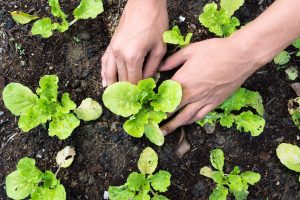Growing your own leaf lettuce can be a rewarding and tasty experience, but it’s crucial to know the ins and outs of providing the right conditions for a thriving crop. Here’s a concise guide to the optimal growing conditions and care for your leafy greens in the garden:
- Sunlight: Leaf lettuce thrives in cooler weather and requires ample sunlight for growth. Plant it in a location that receives partial to full sun, with about 4-6 hours of sunlight per day.
- Temperature: Leaf lettuce is a cool-season crop and prefers temperatures between 50°F to 75°F (10°C to 24°C). It can tolerate light frost but may bolt (flowering and going to seed) prematurely in hot weather, leading to bitter-tasting leaves. To discourage early bolting, keep lettuce in afternoon shade when temperatures are above 85°F (29°C).

When your lettuce seedling reaches a few inches in height with a couple of sets of true leaves, transplant it into a nutrient-rich garden bed, ensuring 6-8 inches of spacing between each plant. - Protection from Heat/Cold: In heat, consider providing shade or using shade cloth (with around 30-50% shading) to prevent the lettuce from becoming stressed and bolting prematurely. In cold conditions (below 40°F/4°C), extend the growing season by using frost cloth/row cover fabric or cold frames to protect the lettuce from frost.
- Watering: Keep the soil consistently moist but not waterlogged. Water the lettuce when the top inch of soil feels dry. Aim to provide deep, even watering to encourage healthy root development. Avoid overhead watering to prevent leaf diseases.
- Soil and Fertilization: Leaf lettuce grows best in well-draining soil rich in organic matter. Prepare the soil by incorporating compost before planting. Apply a balanced, slow-release fertilizer at planting to provide essential nutrients. Avoid excessive nitrogen, which can lead to rapid growth with reduced flavor.
- Transplanting: Once your lettuce seedling has grown a few inches tall and developed a couple of sets of true leaves, transplant it into a 2–3-gallon container with drainage holes or into a nutrient-rich garden bed. If planting in the garden, space each leaf lettuce plant 6-8 inches apart to allow for adequate growth and air circulation.
- Pests and Diseases: Common pests that can affect leaf lettuce include aphids, slugs, and snails. Inspect plants regularly and use least-toxic pest control methods if needed. Proper spacing between plants and promoting good air circulation can help prevent diseases like fungal infections.
- Harvesting: Leaf lettuce can be harvested as soon as the leaves are large enough to eat, typically around 4-6 weeks after planting. Cut the outer leaves with scissors or a sharp knife, leaving the inner leaves to continue growing. This method allows the plant to produce a prolonged harvest.
Remember that leaf lettuce is a fast-growing, tender crop. It’s best to harvest leaves when they are young and tender for the finest flavor and texture. By providing the right conditions and care, you can enjoy a bountiful harvest of fresh, crisp leaf lettuce for your salads and culinary creations.
For more information on growing lettuce, check out the UF/IFAS lettuce website: https://sfyl.ifas.ufl.edu/agriculture/lettuce/
 7
7

